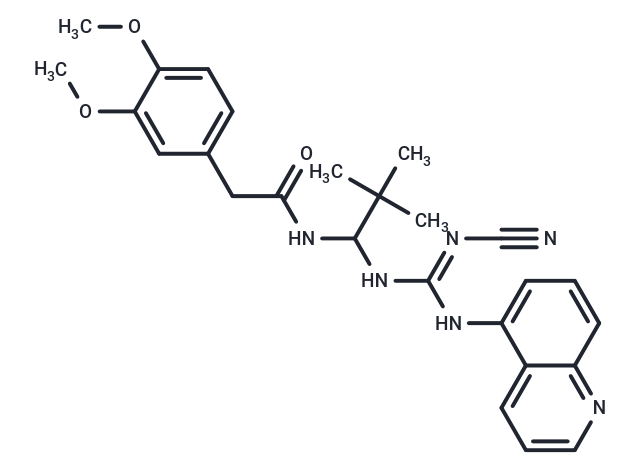Shopping Cart
Remove All Your shopping cart is currently empty
Your shopping cart is currently empty
A-740003 (A 740003) is an effective and specific P2X7 receptor antagonist (IC50: 18/40 nM, for rat/human). It can reduce nociception in animal models of persistent neuropathic and inflammatory pain, and also reduce neuroblastoma tumor growth in mice.

| Pack Size | Price | USA Warehouse | Global Warehouse | Quantity |
|---|---|---|---|---|
| 5 mg | $34 | In Stock | In Stock | |
| 10 mg | $53 | In Stock | In Stock | |
| 50 mg | $72 | In Stock | In Stock | |
| 100 mg | $114 | In Stock | In Stock |
| Description | A-740003 (A 740003) is an effective and specific P2X7 receptor antagonist (IC50: 18/40 nM, for rat/human). It can reduce nociception in animal models of persistent neuropathic and inflammatory pain, and also reduce neuroblastoma tumor growth in mice. |
| Targets&IC50 | P2X7 (rat):18nM, P2X7 (human):40 nM |
| In vitro | A-438079 and A-740003 (10 μM) effectively inhibit the prolonged phase of BzATP-induced responses[1] and mitigate SE-induced TNF-α expression in dentate granule neurons while increasing SE-induced neuronal death[2]. Compared to other antagonists, both compounds exhibit superior efficacy in inhibiting P2X7 receptor activation across various species, with heightened activity in rat and human compared to mouse P2X7 receptors[3]. Specifically, A-740003 robustly inhibits agonist-induced IL-1β release (IC50=156 nM) and pore formation (IC50=92 nM) in differentiated human THP-1 cells[4]. |
| In vivo | Administering A-740003 systemically results in a dose-dependent reduction of pain (antinociception) in rats, as evidenced in a spinal nerve ligation model (ED50=19 mg/kg i.p.), indicating its potency. Furthermore, A-740003 diminishes sensitivity to touch (tactile allodynia) in models of neuropathic pain, including chronic constriction of the sciatic nerve and vincristine-induced neuropathy. It also significantly lowers increased sensitivity to heat (thermal hyperalgesia) following the intraplantar introduction of carrageenan or complete Freund's adjuvant (ED50=38-54 mg/kg i.p.). However, A-740003 does not affect acute thermal pain in healthy rats and does not impair motor skills at doses that relieve pain. |
| Synonyms | A 740003 |
| Molecular Weight | 474.55 |
| Formula | C26H30N6O3 |
| Cas No. | 861393-28-4 |
| Smiles | COc1ccc(CC(=O)NC(N\C(Nc2cccc3ncccc23)=N\C#N)C(C)(C)C)cc1OC |
| Relative Density. | 1.19g/cm3 |
| Storage | Powder: -20°C for 3 years | In solvent: -80°C for 1 year | Shipping with blue ice/Shipping at ambient temperature. | |||||||||||||||||||||||||
| Solubility Information | DMSO: 9.5 mg/mL (20.02 mM), Sonication is recommended. | |||||||||||||||||||||||||
| In Vivo Formulation | 10% DMSO+40% PEG300+5% Tween 80+45% Saline: 1 mg/mL (2.11 mM), Sonication is recommended. Please add the solvents sequentially, clarifying the solution as much as possible before adding the next one. Dissolve by heating and/or sonication if necessary. Working solution is recommended to be prepared and used immediately. The formulation provided above is for reference purposes only. In vivo formulations may vary and should be modified based on specific experimental conditions. | |||||||||||||||||||||||||
Solution Preparation Table | ||||||||||||||||||||||||||
DMSO
| ||||||||||||||||||||||||||
| Size | Quantity | Unit Price | Amount | Operation |
|---|

Copyright © 2015-2025 TargetMol Chemicals Inc. All Rights Reserved.